We might be on the verge of the arrival of the seventh generation of 5 Series but for many the pinnacle of the breed was the fourth incarnation, the E39. It won so many awards during its seven-year production run that BMW had to build a new wing on its HQ to house all the trophies! It might now be 13 years since the last one rolled off the production line, but there are still some gems out there, just waiting to have some love lavished upon them by an enthusiastic owner. We’re going to concentrate on the petrolengined six-cylinder cars here as they are generally cheaper than the equivalent diesels and tend to be overlooked sometimes.
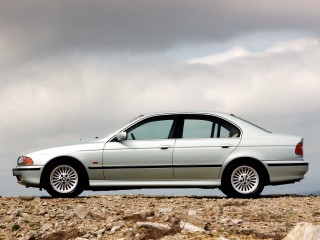
There’s lots to look at when considering an E39 – they’re not it their first flush of youth with the oldest cars now being 20 years old – so we’re going to give you a whistle-stop tour of their history before cracking into the nitty gritty of what goes wrong.
After the success of the BMW E34 many observers wondered how on earth BMW was going to improve upon it significantly with the next generation, but BMW pulled out all the stops and when the car was revealed in 1995 it received almost universal praise, especially when the road testers had got to grips with it. It was larger than the E34 and had a longer wheelbase which improved the E34’s only bete noir, its rear seat legroom. At the same time the E39’s shell was 50 per cent stiffer than it had been before and thanks to the extensive use of aluminium in many of the car’s components it was actually lighter than the E34 despite the size increase.
As far as the engine line-up was concerned the straight-six petrols available at launch were the 2.5-litre 523i and the 2.8-litre 528i, and these were joined in late 1995 by the 2.0-litre 520i. Outputs were 170hp, 193hp and 150hp respectively. A major change in engine-line up happened in 1998 with the arrival of the ‘Technical Update’ for the M52 engine. This saw the adoption of double-Vanos variable valve timing and the adoption of steel liners to banish the Nikasil engine woes to the history books.
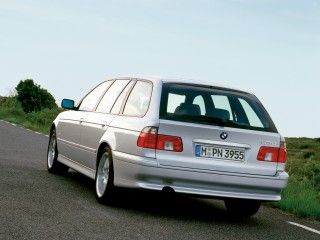
A further change to the engine line-up took place in the latter part of 2000 with the arrival of the M54 straight-six, and it was at this time that the E39 also received its face-lift and the arrival of the now iconic ‘Angel Eye’ headlights. The 520i model designation remained but the engine was now a 170hp 2.2-litre, the 523i was ditched in favour of the 525i with 192hp and the 528i was replaced by the 231hp 530i. This engine line-up would remain until the altogether more controversial BMW E60 replaced the E39 in 2003.
In terms of trim, the two smaller engined models were available as a base spec machine as well as an SE (Special Equipment) and a couple of years later the car was launched as a Sport too. The 528i and the 530i were only ever available in the UK as SE or Sport spec models. When the Sport tag was first used it was a simple package that could be ordered with any other options and didn’t feature the M aerokit that became a very popular offering when the E39 was sold as a Sport in its own right.
Towards the end of the E39’s life there were several special edition models sold by BMW – the Avus Edition, the Midnight blue Edition, the Aegean and the Champagne as well as an ES model for the 520i. These had their own specific Individual colour schemes and a significant amount of additional kit thrown into the bargain by BMW, and if you’re after an E39 to keep these will be the ones to search out.
Bodywork
You’d have thought that by the time the E39 arrived, the old bogey of rust would have been banished. The E34 had an excellent record in this department but the E39 is prone to ferrous oxide – not terrible and not the sort that would put off owners when they were new, but the last E39 is now 13 years old, and the oldest one is now 20. For some reason, the early E39s are better than the later ones. From 1999 onwards the E39 (as well as the BMW E38) seemed to be more prone to scabby rust. Starting at the front, the wings rarely rust and door bottoms are generally okay. But rear arches can rust and so does the bootlid, both around the boot lock, along the bottom seam and around the numberplate lights. The boot slam panel can also rust – it starts behinds the bumper and works its way out resulting in an ugly scab.
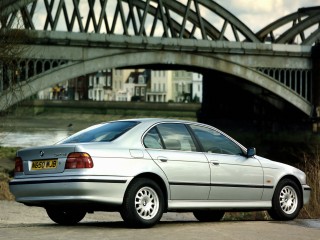
Rust-free bootlids are now becoming scarce and you may find a bootlid from a 1997 car in better condition! More serious is rot in the rear sills caused by lifting underseal, whilst the spare wheel well can grow some alarming holes. Rebuilding rotten rear sills requires the fuel tank dropping down and you may as well replace any rusty brake pipes whilst you’re there. Touring tailgates rust in the same way as saloon bootlids and are a mission to replace. Cracked Sport front bumpers are common, but some of the aftermarket copies are surprisingly good. Wiper mechanisms can break as can exterior door handles – they are either plastic or die-cast metal.
Headlights are a sore point with E39 owners. They have white nylon adjuster posts and they snap off, leaving the inner headlights loose – this is an MoT fail. On pre-2000 cars without xenons, the light can be removed, dismantled and new posts fitted – about a fiver on eBay. Xenon lights are sealed and are a lot more difficult, as are the post- 2000 face-lift lights with angel eye rings. New Chinese-made halogen pre-face-lift lights are around £150 each new, but repairing yours is a vastly cheaper option. Dull lenses can be improved with 1200 grit wet and dry with a polishing mop and compound. New xenons are a grand each from BMW but can be found for £650 elsewhere. Finally, a bootlid that won’t stay shut will be a broken spring in the boot latch. Good new ones are easy to find.
Buying one
If you’re after a cheap runabout we found a lot of E39s for sale with long MoTs and not ridiculous mileage for around £500. At the other end of the scale, Hexagon has a manual 2002 530i with all the bells and whistles and less than 14k miles for £26,995! Who would have thought you’d be able to buy a virtually new E39 from a BMW dealer in 2016 with an Approved Used warranty?
Somewhere in between these two pricing extremes you’ll be able to find plenty of E39s up for grabs with very decent machinery with less than 100k miles on offer from anywhere in between £3000 and £7000. Don’t be put off higher mileage machines though, these cars can wear the miles well, and look for plenty of evidence of recent expenditure.
Engine
Up until September 1998 (S registration), the E39 used the BMW E36 type M52 single Vanos alloy block engine. These were 1991cc for the 520i, 2494cc for the 523i and 2793cc for the 528i. The M52 used a simple cable operated throttle and had the crank sensor at the front of the engine operating on the front pulley. It used a plastic cam cover, single coil packs and until early March 1998, Nikasil bore coatings. BMW used two processes to avoid using steel bore liners: Alusil and Nikasil. Alusil was used on the V12 and later V8 units. It is a silicon impregnated alloy requiring no additional coatings and it was never used on the sixes. Nikasil, however, is a nickel silicon coating applied to the bores and was used on all early M52s – however, our US readers will know that their market E39 528i (520i and 523i cars were not officially sold there) used a cast iron block as it was well-known that US fuel contained a lot of sulphur.
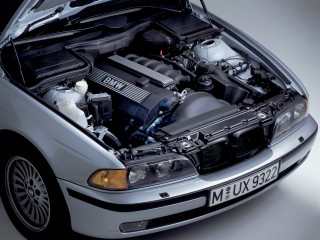
Nikasil was fine in theory, but it could be damaged by the aggressive cold start fuelling that the M50 and M52 used – they are very easy to flood. The correct way to start these was to start it normally, and avoid shutting it off until the engine has some heat in it – that’s why high mileage motorway cars could do 200,000 miles on one Nikasil block and still be okay. However, even at this late stage, too many cold starts can still damage the bores – bore wash leads to the coating becoming scratched and it can lift, resulting in low compression. High oil consumption and a shaky idle are symptoms and the catalyst will eventually stop working due to oil contamination.
From March 1998, steel liner blocks were phased in, often incorrectly called ‘alusil blocks’. These are identified by a small (rusty) steel plate secured to the block under the starter motor – Nikasil engines have a pear-shaped lug cast into the alloy block for the (as then-unused) crank sensor and steel liner blocks have that metal plate with a small bolt. Nikasil apart, the M52 is a good engine. Head gasket failure can occur and forget any notion of replacing it – just fit another engine. The problem is the threads in the block will weaken over time – these are guaranteed to strip on retightening and forget about helicoils or timeserts as they will just come out again. Steel liner blocks also had a problem where the alloy ‘sinks’ between the liners and only a strip down and a block skim will sort it – not worth it when a good used engine is 300 quid! The plastic impeller water pumps had a bad reputation that is underserved. They can fail after ten years or so, but how long is it supposed to last? Even so, make a new steel impeller pump a priority – they’re only 30 quid aftermarket and easy enough to fit. The Vanos unit is very reliable and just gets a bit noisy in old age.
From September 1998, the M52TU arrived, alloy blocked in all markets – USA included. This engine had double Vanos and a new electro mechanical throttle body linked to the ASC traction control system. The engine is similar but it has a new, extra large coolant channel meaning the block and head are not interchangeable with the previous engine. The seals in the Vanos unit wear, leading to a gradual drop off in performance but they can be removed and rebuilt with teflon seals. The head gaskets are less likely to fail on these but heads have been known to crack.
Water pumps are the same as before and they are all steel liner engines so no bore wear. Timing chains last forever and with care they are a 250,000 mile engine. The twin-Vanos 2.8 is a really good engine – so good that BMW breakers very rarely sell one. The throttle body can fail – the engine will idle but not rev, and this is down to the throttle disc jamming. Sometimes they can be removed, cleaned up and will live again with the wear ridge in the alloy housing polished out with fine emery.
The M54 arrived in late 2000 and is basically an M52TU with knobs on. The 2.0 became a 2.2, the 523i became a 525i (still with 2494cc) and the 528i was replaced by the 530i. The main differences were in the ancillaries – the block, sump and head castings are very similar. The throttle body was now fully electronic fly-by-wire, and the exhaust manifold now had a pair of catalysts. Neither of these two additions pose much of a problem although the throttle body can play up and a used one may not work without proper coding with INPA. Oil consumption on the M54 can be high, particularly the 530i and apart from trying a slightly thicker grade of oil such as 10w30 there’s not much you can do.
The M54 crankcase ventilation system will need replacing by now – the canister and all the pipes. Removing the inlet manifold is the best way of doing it if you’ve not done one before. The plastic cam cover can crack and leak oil but a good used one with a new rubber gasket is fine – be aware that in 2003 the M54 went to push fit coil packs just before the E60 went into production. These engines also have a DISA unit to vary inlet air speed, and it’s not unknown for the flap to break off and get ingested by the engine – so remove it, clean it and check it over.
We mentioned the water pump earlier, but twin- Vanos cars had a new style radiator with the push fit hoses, a separate header tank (expansion bottle) as well as a mapped thermostat. Single-Vanos cars had a simple E30-style radiator with integral header tank, standard type thermostat and a jubilee clip type hose – very easy to work on whilst the later setup is not. If replacing a 1998-onwards radiator with the push fit hoses, avoid cheap rads as they leak from the hose fittings – pay a bit more and buy a Nissens or Behr rad which are around 80 quid these days.
Transmission and drivetrain
There are five-speed manual and five-speed auto boxes on the E39. Starting with the manuals, the 520i uses the small Getrag 250 gearbox and the rest use the ZF310/320 unit. All are good, strong units that rarely give trouble and are cheap to replace. The M52TU and M54 cars use a dual mass flywheel with a clutch that requires special tools to set up – not a DIY job. Clutch hydraulics are all good and overall, the manual E39s are no problem. Autos are also good but with provisos.
The older units on single-Vanos cars were more robust, but they’re also older now. Later ones can give trouble and it’s normally due to a failed thrust washer or a broken clutch drum. By the time the car goes into limp home mode (trans warning on the dash and stuck in third gear) the gearbox has pretty much had it and it’s unlikely that an oil change will help. Oil changes are a moot point as these boxes were sealed for life. Some say if it’s working, leave it alone. Others say change the oil. But bear in mind that by 100,000 miles the gearbox is quite a way though its lifespan and as a compromise, we’d say draining the sump, fitting a new filter and topping up with new oil is as far as you should go.
Pay attention to the oil cooler pipes as they’re at the age where they can leak, and running an auto box low on oil is bad. A gearbox rebuild is £2000 plus, and an E39 is rarely worth enough to warrant it – a good used box from FAB or Quarry Motors for a fraction of that is a better plan. Replace the converter oil seal and filter, new oil and away you go. Be aware that four other things can also cause a gearbox to go into failsafe mode – a faulty crank or cam sensor, worn out rear tyres and a dying/wrong battery. Diffs are strong and rarely fail, but be aware that there are various different ratios, diff sizes and different driveshafts – BMW didn’t make it easy!
Steering and suspension
The saloons are very good in this department. Nothing really goes wrong and the alloy bodied dampers seem to last forever as do the wishbones and bushes – they really are very robust and a lot better than the E34 was. Even when parts are needed, they are as cheap as chips new from the aftermarket and a pair of good used front struts are the price of a reasonable pair of trainers. New front dampers are £100 each from Sachs, or £350 from BMW – take your pick! Steering racks don’t really give trouble and the PAS pumps never seem to fail. Of course there will always be exceptions, but as a rule, they’re outstandingly good in this department.
The Touring rear air suspension is a different story. An optional extra in Europe, all UK cars have this system as standard that is great when it works and a pain when it doesn’t. Self-levelling sensors on the rear suspension give signals to the control unit in the driver’s rear boot well, and that tells the compressor unit in the spare wheel well to pump air into the rear air springs. Compressors fail, but used ones are under 100 quid now, and pattern air springs are around 100 quid each. You would not be the first E39 Touring buyer to find that the day after purchase, the back end has dropped to the floor, only to lift up again when the engine is started and the pump activates. A conversion to coils is possible – companies like Mister Auto sell a pair of coils for about £120 and most have found that the rear dampers for the air spring cars work fine on coils. A pair of standard rear dampers won’t break the bank at £80 each but try it on the originals first.
You will need to have the air suspension failure warning coded out of the instrument cluster, or replace it with a cluster from a saloon with the same engine and similar build date with a similar mileage – it will still require coding to the car. Front wheel bearings are complete bolt on units and are very easy to replace.
Electronics
We’ve already mentioned a few possible electronic gremlins, but here are a few more. A failed ignition switch can cause loss of the radio, cruise control, multi-function steering wheel and others – ABS warning light, airbag warning light and even a non start. However, they’re not expensive new at £75 and are simple to replace. A non-working rear wiper on Tourings as well as a faulty tailgate lock can be due to broken wires where the tailgate loom passes into the rear body – a time consuming repair. Central locking never seems to fail, but whilst batteries in the pre-2000 type keys can be replaced, those in the later ‘diamond’ keys cannot. Some have managed to get the key apart to replace the battery but there is a high risk of rendering the key and the EWS chip within useless.
What can be done though is to get another key with a good battery from a breakers, and have a BMW specialist with the correct software to code it to the car – then you can cut the blade off and have it on the keyring as a new ‘blipper’.
Lastly – E39s need a good battery. If it’s tired or the wrong type, many functions as well as the automatic gearbox will play up.
Wheels, tyres and brakes
These cars come on a variety of wheels – 15-inch standard, 16-inch ‘spoons’, 17- and 18-inch multispoke, 16-inch BBS-style plus 18-inch M Parallels. Some cars even have ‘steel’ wheels with plastic wheel trims – these wheels are actually alloy so don’t throw them away! All are likely to require refurbing now but the 16-inch ‘spoon’ alloys are so cheap second-hand, it’s not worth the bother.
Brakes are straightforward, and discs and pads are cheap. Pre-September 1998 cars have a simple ASC system, and the ABS block and ECU rarely give any trouble. Not so with the later ASC-type introduced with the twin-Vanos engine. This ABS ECU is a Bosch unit with a part number ending in 001, and they regularly fail resulting in the ABS light coming on and a speedo failure. The diagnostics may well show a dead sensor. By all means replace it, but don’t be surprised if the fault hasn’t cleared. Good used ones are £100, new ones from BMW are a predictable £850 and a new Bosch one can be bought from Andrew Page Ltd for around £350 – they are a straight swap and rarely need coding.
The units used on cars with DSC are a lot more money (around £500 new) and require coding – this is because the slip ring (or squib) in the steering wheel communicates with the DSC. The DSC system also has a pre-charge pump in the engine bay that gives brake pressure to an individual wheel when needed. They’re quite reliable but as most six-cylinder E39s made do with ASC, you may struggle to find a used one although E38 7 Series parts are often the same. All E39s are old enough now to have rusty brake pipes, and most will need a few replacing.
Interior
The interior was the E39’s calling card. The E39’s plastics are good and solid, window regulators rarely fail and the wood trims can be fitted to basic cars, painted a different colour and swapped and changed. Steering wheels fall into three categories: cars up to September 1998, post-September ‘98 cars and late ones from 2001. They don’t interchange either so bear this in mind if planning an upgrade.
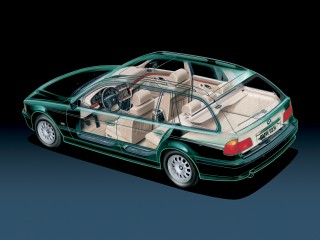
Dashboard pixels are a problem and can fail an MoT if the mileage can’t be read. Good used clusters are cheap, but match the part number (either current or by supersession) and code it to the car. If the car has sat nav, make sure the disc is present and it still works but don’t expect miracles from something as modern and advanced as a G3 iMac.
Radios are okay. The pre-2001 round pin connector plug Philips units were good but the later flat pin Becker units less. On Tourings, poor radio reception will be the aerial amplifier in the passenger C pillar – just fit a new one. The cup holders are known to break, but they’re next-to-useless anyway! Interior chrome door handles can break but switches and column stalks are all good, although the buttons can fall off the climate control panel.
Cloth trim was hard- wearing, but by now many will be getting threadbare and decent leather interiors are cheap – in the case of grey and beige, we’ve seen them sell on eBay for £30. Black leather trim is always more valuable, and the interiors with Sports front seats can sell for up to £400. Don’t worry about worn bolsters, as a good trimmer can replace a worn outer section for as little as £60 all-in.
Some cars were sold in the UK without air conditioning, normally early 520i and 523i cars. Others will have either manual air-con or a fully automatic system, and it needs to work.
Sometimes a re-gas will get it going again if only to pinpoint where a leak is, but new condensers are cheap at £75 and a good used compressor is £50 tops. Make sure the electric AC fan works though – many are seized. Door seals were known to creak, but rubbing vaseline into them helps a lot.
Verdict
The E39 was great when it was built and today a good example is still superb – even a basic 520i manual still has a supple ride and a smooth quietness. As for which one to buy, it depends on what you want but don’t think that the newer the car, the better. For robustness, the original single- Vanos cars are best and a nice, low mileage 528i is worth having. Also, early cars make the best ‘bangers’, cheap cars that are easy and inexpensive to maintain. No flaky ‘001’ ABS ECUs or knackered Vanos units but a nice late model 530i, especially a Sport model. Be aware that they’re now at the age where preventative maintenance is needed – underbody examination and treatment, looking closely at the cooling system and being prepared for some big invoices. On the other hand, the E39 is a reliable and well-built car and at half the price of an equivalent E60, well worth owning.
| TYPE | BMW DEALER | SPECIALIST |
| OIL SERVICE WITH MICRO FILTER | £189 | £145 |
| INSPECTION 1 | £299 | £230 |
| INSPECTION 2 | £389 | £300 |
| BRAKE FLUID | £71 | £60 |
| FRONT OR REAR PADS | £129 | £90 |
| FRONT DISCS AND PADS | £275 | £200 |
| REAR DISCS AND PADS | £249 | £190 |
|
Price is for a 2003 520i auto but all six-cylinder E39s should be the same. Specialist prices takes from a cross section of specialists. |
||





